

Compact Muon Solenoid
LHC, CERN
| CMS-PAS-EXO-16-010 | ||
| Search for dark matter and unparticles in events with a Z boson and missing transverse momentum in proton-proton collisions at $ \sqrt{s} = $ 13 TeV | ||
| CMS Collaboration | ||
| August 2016 | ||
| Abstract: A search for evidence of dark matter (DM) and unparticle production at the LHC has been performed using events containing two charged leptons, consistent with the decay of a Z boson, and large missing transverse momentum. This study is based on data collected with the CMS detector corresponding to an integrated luminosity of 2.3 fb$^{-1}$ of pp collisions at the LHC at a center-of-mass energy of 13 TeV. No excess over the standard model expectation is observed. The results are interpreted in terms of a simplified model of DM production. For both vector and axial vector couplings between a mediator and DM particles, 95% confidence level limits are set on the observed signal strength in the plane of mediator and DM particle mass. Additionally, 90% confidence level limits are set on the DM-nucleon scattering cross section, as a function of the DM particle mass, for both spin-dependent and spin-independent coupling scenarios. In the context of an effective field theory, 95% confidence level limits are set on the DM coupling parameters to U(1) and SU(2) gauge fields and on the scale of new physics. Additionally, 95% confidence level limits are obtained on the unparticle model parameters. | ||
|
Links:
CDS record (PDF) ;
inSPIRE record ;
CADI line (restricted) ;
These preliminary results are superseded in this paper, JHEP 03 (2017) 061 [Erratum: JHEP 09 (2017) 106]. The superseded preliminary plots can be found here. |
||
| Figures | |
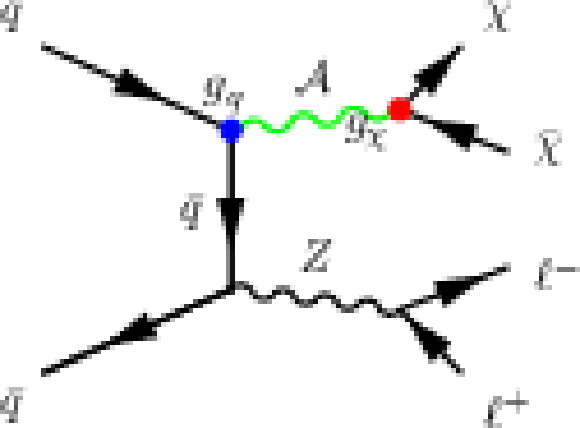
png pdf |
Figure 1-a:
Feynman diagrams for production of DM pairs ($\chi \bar{\chi }$) in association with a Z boson. a: the simplified model containing a vector mediator A. b: an EFT benchmark model with DM pair coupling to gauge bosons via dimension-7 operators. |

png pdf |
Figure 1-b:
Feynman diagrams for production of DM pairs ($\chi \bar{\chi }$) in association with a Z boson. a: the simplified model containing a vector mediator A. b: an EFT benchmark model with DM pair coupling to gauge bosons via dimension-7 operators. |

png pdf |
Figure 2:
Feynman diagram for unparticle (denoted by $\mathcal U$) production in association with a Z boson. The hatched circle indicates the interaction modeled with an effective field theory operator. |

png pdf |
Figure 3-a:
The distribution in ${E_{\mathrm {T}}^{\text {miss}}}$ at the generator level, for simplified DM model with vector coupling (a), EFT DM model (b), and unparticle scenarios. The DM curves are shown for different values of the vector mediator mass $M_{\rm med}$ in the left pane and for different values of the DM mass $m_\chi $ in the right pane (note the different binning due to a much broader shape). The unparticle curves have the scalar unparticle coupling $\lambda $ between unparticle and SM fields set to 1, with the scaling dimension $d_\mathcal {U}$ ranging from 1.06 to 2.2. The SM background $ { {\mathrm {Z}}} { {\mathrm {Z}}} \to \ell ^{-}\ell ^{+} {\nu } {\overline {\nu }} $ is shown as a red solid histogram. |

png pdf |
Figure 3-b:
The distribution in ${E_{\mathrm {T}}^{\text {miss}}}$ at the generator level, for simplified DM model with vector coupling (a), EFT DM model (b), and unparticle scenarios. The DM curves are shown for different values of the vector mediator mass $M_{\rm med}$ in the left pane and for different values of the DM mass $m_\chi $ in the right pane (note the different binning due to a much broader shape). The unparticle curves have the scalar unparticle coupling $\lambda $ between unparticle and SM fields set to 1, with the scaling dimension $d_\mathcal {U}$ ranging from 1.06 to 2.2. The SM background $ { {\mathrm {Z}}} { {\mathrm {Z}}} \to \ell ^{-}\ell ^{+} {\nu } {\overline {\nu }} $ is shown as a red solid histogram. |
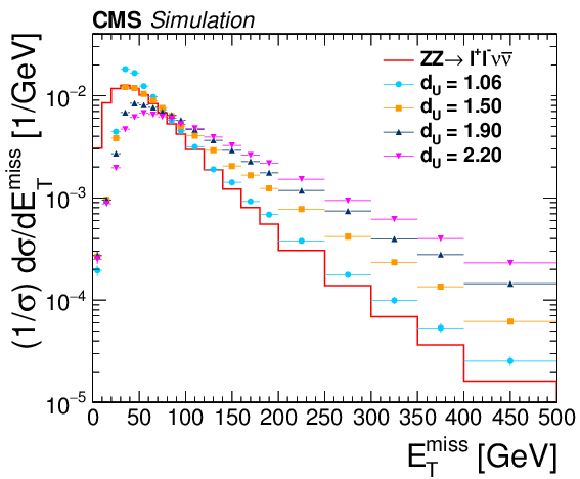
png pdf |
Figure 3-c:
The distribution in ${E_{\mathrm {T}}^{\text {miss}}}$ at the generator level, for simplified DM model with vector coupling (a), EFT DM model (b), and unparticle scenarios. The DM curves are shown for different values of the vector mediator mass $M_{\rm med}$ in the left pane and for different values of the DM mass $m_\chi $ in the right pane (note the different binning due to a much broader shape). The unparticle curves have the scalar unparticle coupling $\lambda $ between unparticle and SM fields set to 1, with the scaling dimension $d_\mathcal {U}$ ranging from 1.06 to 2.2. The SM background $ { {\mathrm {Z}}} { {\mathrm {Z}}} \to \ell ^{-}\ell ^{+} {\nu } {\overline {\nu }} $ is shown as a red solid histogram. |
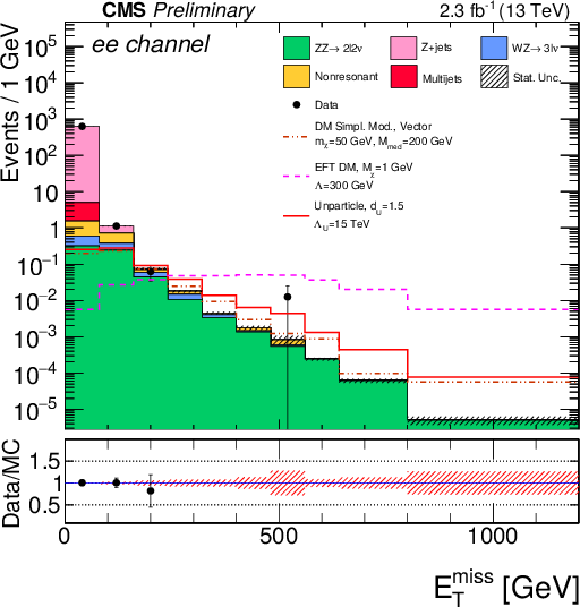
png pdf |
Figure 4-a:
The distribution of ${E_{\mathrm {T}}^{\text {miss}}}$ after preselection for the $ { {\mathrm {Z}}} \to {\mathrm {e}^+} {\mathrm {e}^-}$ (a) and $ { {\mathrm {Z}}} \to {{\mu ^+}} {{\mu ^-}}$ (b) channels. Expected signal distributions are shown for the simplified model of DM production with vector couplings, the EFT scenario of DM production, and unparticles. The shown SM expectation is based on simulation only. The total statistical uncertainty in the overall background prediction is shown as a hatched region. Overflow events are included in the rightmost bins. In the bottom panels, the ratio between data and predicted background is shown. |

png pdf |
Figure 4-b:
The distribution of ${E_{\mathrm {T}}^{\text {miss}}}$ after preselection for the $ { {\mathrm {Z}}} \to {\mathrm {e}^+} {\mathrm {e}^-}$ (a) and $ { {\mathrm {Z}}} \to {{\mu ^+}} {{\mu ^-}}$ (b) channels. Expected signal distributions are shown for the simplified model of DM production with vector couplings, the EFT scenario of DM production, and unparticles. The shown SM expectation is based on simulation only. The total statistical uncertainty in the overall background prediction is shown as a hatched region. Overflow events are included in the rightmost bins. In the bottom panels, the ratio between data and predicted background is shown. |
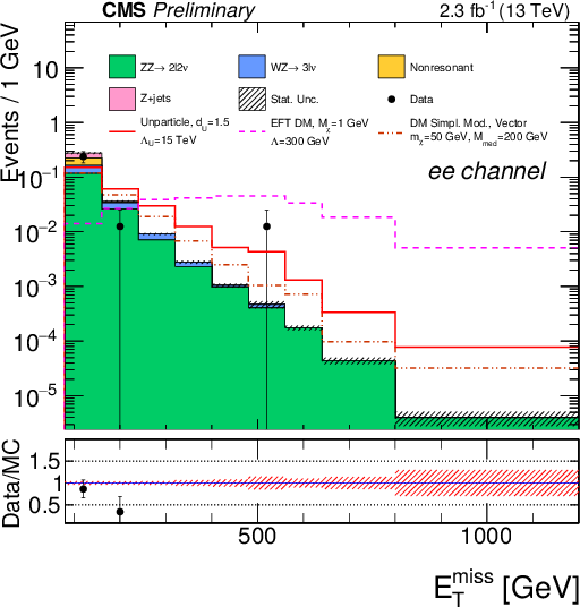
png pdf |
Figure 5-a:
Distributions of the ${E_{\mathrm {T}}^{\text {miss}}}$ for the final selection in the $ {\mathrm {e}^+} {\mathrm {e}^-}$ (a) and $ {{\mu ^+}} {{\mu ^-}}$ (b) channels. Expected signal distributions are shown for the simplified model of DM production with vector couplings, the EFT scenario of DM production, and unparticles. The statistical uncertainty in the overall background is shown as a hatched region. Overflow events are included in the rightmost bins. In the bottom panels, the ratio between data and predicted background is shown. |

png pdf |
Figure 5-b:
Distributions of the ${E_{\mathrm {T}}^{\text {miss}}}$ for the final selection in the $ {\mathrm {e}^+} {\mathrm {e}^-}$ (a) and $ {{\mu ^+}} {{\mu ^-}}$ (b) channels. Expected signal distributions are shown for the simplified model of DM production with vector couplings, the EFT scenario of DM production, and unparticles. The statistical uncertainty in the overall background is shown as a hatched region. Overflow events are included in the rightmost bins. In the bottom panels, the ratio between data and predicted background is shown. |

png pdf |
Figure 6-a:
The 95%CL observed limits on the signal strength $\sigma _{\rm obs}/\sigma _{\rm theo}$ in both vector (a,b) and axial-vector (c,d) mediator scenarios, for mediator-quark coupling constant values $g_{\rm q} =$ 0.25 (a,b) and $1$ (c,d). In all cases, the DM-mediator coupling $g_{\chi }$ is set to one. The expected exclusion curves for unity signal strength are shown as a reference. The red dashed lines show the influence of theory-related signal normalization uncertainties on the observed limits, which are estimated to be 15%. |
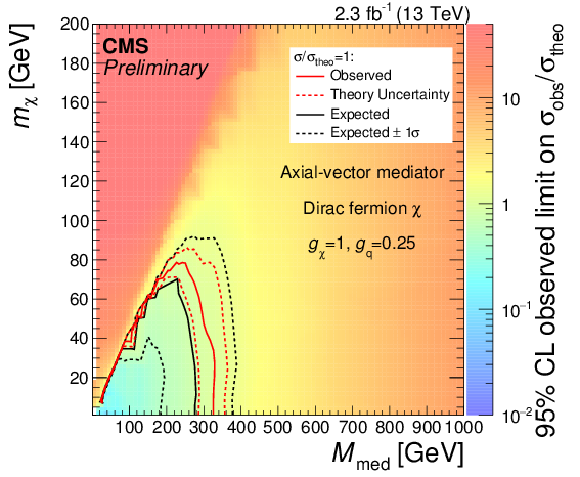
png pdf |
Figure 6-b:
The 95%CL observed limits on the signal strength $\sigma _{\rm obs}/\sigma _{\rm theo}$ in both vector (a,b) and axial-vector (c,d) mediator scenarios, for mediator-quark coupling constant values $g_{\rm q} =$ 0.25 (a,b) and $1$ (c,d). In all cases, the DM-mediator coupling $g_{\chi }$ is set to one. The expected exclusion curves for unity signal strength are shown as a reference. The red dashed lines show the influence of theory-related signal normalization uncertainties on the observed limits, which are estimated to be 15%. |
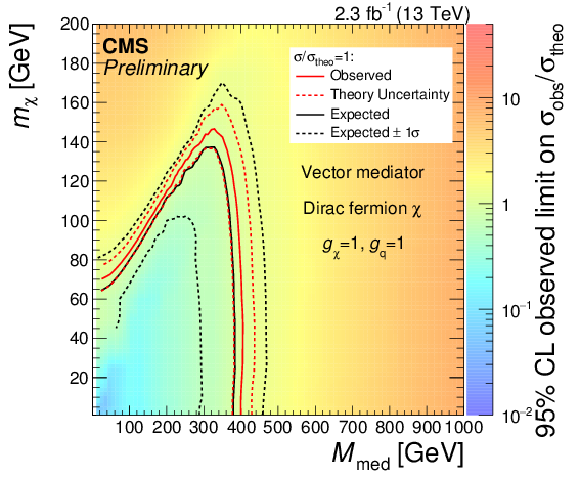
png pdf |
Figure 6-c:
The 95%CL observed limits on the signal strength $\sigma _{\rm obs}/\sigma _{\rm theo}$ in both vector (a,b) and axial-vector (c,d) mediator scenarios, for mediator-quark coupling constant values $g_{\rm q} =$ 0.25 (a,b) and $1$ (c,d). In all cases, the DM-mediator coupling $g_{\chi }$ is set to one. The expected exclusion curves for unity signal strength are shown as a reference. The red dashed lines show the influence of theory-related signal normalization uncertainties on the observed limits, which are estimated to be 15%. |

png pdf |
Figure 6-d:
The 95%CL observed limits on the signal strength $\sigma _{\rm obs}/\sigma _{\rm theo}$ in both vector (a,b) and axial-vector (c,d) mediator scenarios, for mediator-quark coupling constant values $g_{\rm q} =$ 0.25 (a,b) and $1$ (c,d). In all cases, the DM-mediator coupling $g_{\chi }$ is set to one. The expected exclusion curves for unity signal strength are shown as a reference. The red dashed lines show the influence of theory-related signal normalization uncertainties on the observed limits, which are estimated to be 15%. |

png pdf |
Figure 7-a:
Observed 90% CL limits on the DM-nucleon scattering cross sections in both spin-independent (a) and spin-dependent (b) cases, assuming a mediator-quark coupling constant $g_{\rm q} =$ 0.25 and mediator-DM coupling constant $g_{\chi } =$ 1. Limits from the LUX [68], CDMSLite [69], PandaX-II [70], and CRESST-II [71] experiments are shown for the spin-independent case. Limits from the Super-Kamiokande [72], PICO-2L [73], PICO-60 [74], and IceCube [75] experiments are shown for the spin-dependent case. |

png pdf |
Figure 7-b:
Observed 90% CL limits on the DM-nucleon scattering cross sections in both spin-independent (a) and spin-dependent (b) cases, assuming a mediator-quark coupling constant $g_{\rm q} =$ 0.25 and mediator-DM coupling constant $g_{\chi } =$ 1. Limits from the LUX [68], CDMSLite [69], PandaX-II [70], and CRESST-II [71] experiments are shown for the spin-independent case. Limits from the Super-Kamiokande [72], PICO-2L [73], PICO-60 [74], and IceCube [75] experiments are shown for the spin-dependent case. |

png pdf |
Figure 8:
The 95%CL expected and observed limits on the cutoff scale $\Lambda $ as a function of DM mass $m_\chi $. |
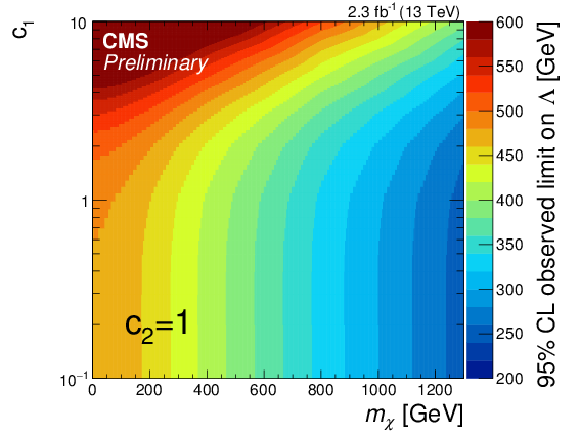
png pdf |
Figure 9-a:
The 95%CL observed limits on the cutoff scale $\Lambda $ (a) and signal strength $\sigma ^{\rm obs}/\sigma ^{\rm th}$ (b) as a function of coupling $c_1$ and DM mass $m_\chi $. The expected exclusion curves for unity signal strength are shown as a reference. |
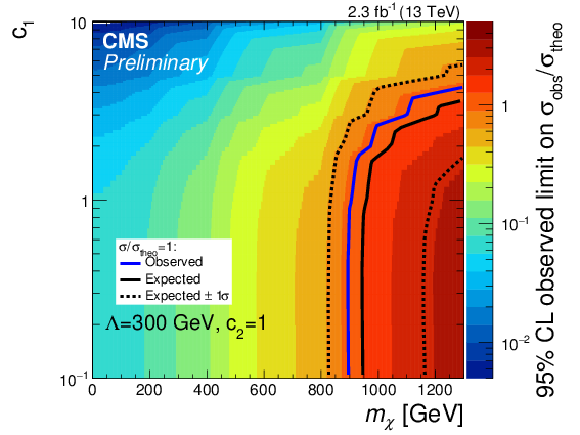
png pdf |
Figure 9-b:
The 95%CL observed limits on the cutoff scale $\Lambda $ (a) and signal strength $\sigma ^{\rm obs}/\sigma ^{\rm th}$ (b) as a function of coupling $c_1$ and DM mass $m_\chi $. The expected exclusion curves for unity signal strength are shown as a reference. |

png pdf |
Figure 10:
The 95% CL lower limits on unparticle effective cutoff scale $\Lambda _\mathcal {U}$ with a fixed coupling $\lambda =1$. The results from CMS monojet [3] and mono-Z [17] searches, as well as a reinterpretation of LEP searches [76] are shown for comparison. |
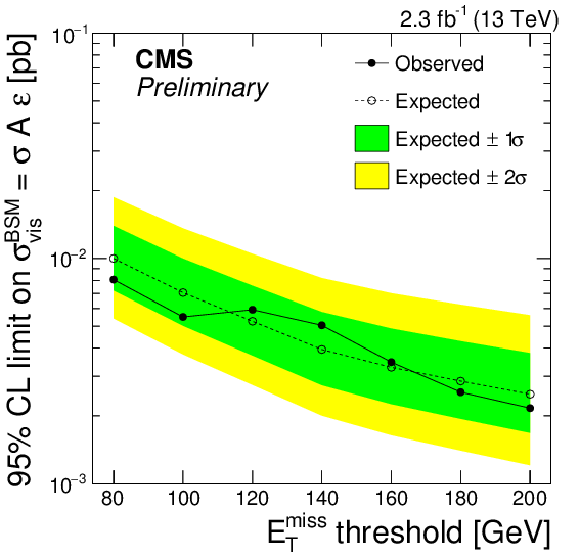
png pdf |
Figure 11:
The model-independent upper limits at 95% CL on the visible cross section ($\sigma A \epsilon $) for BSM production of events, as a function of ${E_{\mathrm {T}}^{\text {miss}}}$ threshold. |
| Tables | |
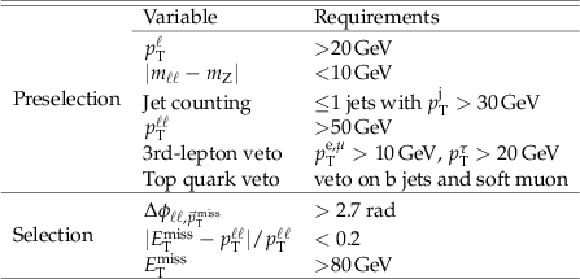
png pdf |
Table 1:
Summary of selections used in the analysis. |

png pdf |
Table 2:
Summary of systematic uncertainties. Each background uncertainty represents the variation of the relative yields of the particular background components. The signal uncertainties represent the relative variations in the signal acceptance, and ranges quoted cover both signals of DM and unparticles with different DM masses or scaling dimensions. For shape uncertainties, the numbers correspond to the overall effect of the shape variation on the yield or acceptance. The symbol ``-- '' indicates that the systematic uncertainty is not applicable. The impact of the each group of systematic uncertainties is calculated by performing a maximum likelihood fit to obtain the signal strength with each parameter separately varied up and down within its uncertainty. The number given in the impact column is the relative change of the best fit signal strength that is introduced by the variation for a the simplified model signal scenario with a vector mediator of mass 200 GeV and DM of mass 50 GeV. |
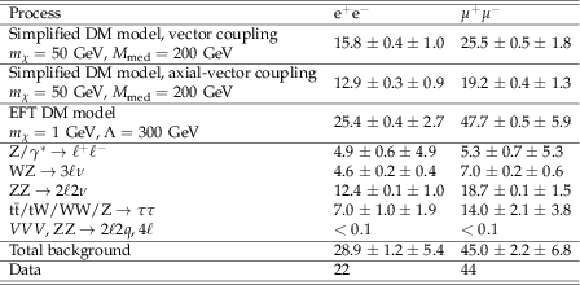
png pdf |
Table 3:
Signal predictions and background estimates for the final selection with $ {E_{\mathrm {T}}^{\text {miss}}} >$ 80 GeV. The DM signal yields from the simplified model are given for mass $m_\chi =$ 50 GeV and mediator masses $M_{\rm med} =$ 200 GeV for the vector and axial-vector coupling scenarios. For the EFT benchmark model with DM pair coupling to gauge bosons, the signal yields are given for $m_\chi =$ 1 GeV, cutoff scale $\Lambda =$ 300 GeV, and the couplings $c_1=c_2=$ 1. The corresponding statistical and systematic uncertainties are shown, in that order. |
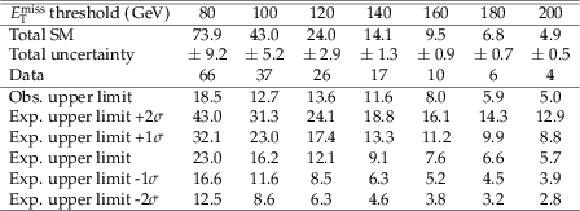
png pdf |
Table 4:
Total SM background predictions for the numbers of events passing the selection requirements, for different ${E_{\mathrm {T}}^{\text {miss}}}$ thresholds, compared with the observed numbers of events. The listed uncertainties include both statistical and systematic components. The 95% CL observed and expected upper limits for the contribution of events from BSM sources are also shown. The ${\pm }1\sigma $ and ${\pm }2\sigma $ excursions from expected limits are also given. |
| Summary |
| A search is performed with the final state of a Z boson plus missing transverse energy on a dataset corresponding to an integrated luminosity of 2.3 fb$^{-1}$ of pp collisions at a center-of-mass energy of 13 TeV. The observed data are consistent with the expected SM backgrounds. The results are analyzed to obtain limits in three different scenarios of physics beyond the SM. In a simplified model of DM production via a vector or axial vector mediator, 95% CL limits are obtained on the masses of the DM particles and the mediator. Limits on the DM-nucleon scattering cross section are set at 90% CL in spin-dependent and spin-independent coupling scenarios. In an effective field theory model, limits are set on the DM coupling parameters to U(1) and SU(2) gauge fields and on the scale of new physics. For an unparticle model, 95% CL limits are obtained on the effective cutoff scale as a function of the scaling dimension. In addition, model-independent limits on the contribution to the visible Z+$E_{\mathrm{T}}^{\text{miss}}$ cross section from non-SM sources are presented as a function of the minimum requirement on $E_{\mathrm{T}}^{\text{miss}}$. |
| References | ||||
| 1 | P. Cushman et al. | Snowmass CF1 Summary: WIMP Dark Matter Direct Detection | 1310.8327 | |
| 2 | J. Buckley et al. | Indirect Dark Matter Detection CF2 Working Group Summary | 1310.7040 | |
| 3 | CMS Collaboration | Search for dark matter, extra dimensions, and unparticles in monojet events in proton-proton collisions at $ \sqrt{s} $ = 8 TeV | EPJC 75 (2015) 235 | CMS-EXO-12-048 1408.3583 |
| 4 | CMS Collaboration | Search for dark matter with jets and missing transverse energy at 13 TeV | CMS-PAS-EXO-15-003 | CMS-PAS-EXO-15-003 |
| 5 | ATLAS Collaboration | Search for new phenomena in final states with an energetic jet and large missing transverse momentum in pp collisions at $ \sqrt{s}=8 $ TeV with the ATLAS detector | EPJC 75 (2015) 299 | 1502.01518 |
| 6 | CMS Collaboration | Search for new phenomena in monophoton final states in proton-proton collisions at $ \sqrt s = $ 8 TeV | PLB755 (2016) 102--124 | CMS-EXO-12-047 1410.8812 |
| 7 | ATLAS Collaboration | Search for new phenomena in events with a photon and missing transverse momentum in pp collisions at $ \sqrt{s}=8 $ TeV with the ATLAS detector | PRD 91 (2015) 012008 | 1411.1559 |
| 8 | CMS Collaboration | Search for physics beyond the standard model in final states with a lepton and missing transverse energy in proton-proton collisions at $ \sqrt{s} $ = 8 TeV | PRD 91 (2015) 092005 | CMS-EXO-12-060 1408.2745 |
| 9 | ATLAS Collaboration | Search for dark matter in events with heavy quarks and missing transverse momentum in pp collisions with the ATLAS detector | EPJC 75 (2015) 92 | 1410.4031 |
| 10 | ATLAS Collaboration | Search for dark matter in events with a hadronically decaying W or Z boson and missing transverse momentum in pp collisions at $ \sqrt{s} $ = 8 TeV with the ATLAS detector | PRL 112 (2014) 041802 | 1309.4017 |
| 11 | ATLAS Collaboration | Search for new particles in events with one lepton and missing transverse momentum in pp collisions at $ \sqrt{s} $ = 8 TeV with the ATLAS detector | JHEP 09 (2014) 037 | 1407.7494 |
| 12 | ATLAS Collaboration | Search for invisible particles produced in association with single-top-quarks in proton-proton collisions at $ \sqrt{s} $ = 8 TeV with the ATLAS detector | EPJC 75 (2015) 79 | 1410.5404 |
| 13 | ATLAS Collaboration | Search for Dark Matter in Events with Missing Transverse Momentum and a Higgs Boson Decaying to Two Photons in $ pp $ Collisions at $ \sqrt{s}=8 $ TeV with the ATLAS Detector | PRL 115 (2015), no. 13, 131801 | 1506.01081 |
| 14 | CMS Collaboration | Search for Monotop Signatures in Proton-Proton Collisions at $ \sqrt{s}=8 $ TeV | PRL 114 (2015) 101801 | CMS-B2G-12-022 1410.1149 |
| 15 | CMS Collaboration | Search for the production of dark matter in association with top-quark pairs in the single-lepton final state in proton-proton collisions at $ \sqrt{s} $ = 8 TeV | JHEP 06 (2015) 121 | CMS-B2G-14-004 1504.03198 |
| 16 | ATLAS Collaboration | Search for dark matter in events with a Z boson and missing transverse momentum in pp collisions at $ \sqrt{s} $ = 8 TeV with the ATLAS detector | PRD 90 (2014) 012004 | 1404.0051 |
| 17 | CMS Collaboration | Search for dark matter and unparticles produced in association with a Z boson in proton-proton collisions at $ \sqrt s= $ 8 TeV | PRD93 (2016) 052011 | CMS-EXO-12-054 1511.09375 |
| 18 | D. Abercrombie et al. | Dark Matter Benchmark Models for Early LHC Run-2 Searches: Report of the ATLAS/CMS Dark Matter Forum | 1507.00966 | |
| 19 | H. Georgi | Unparticle physics | PRL 98 (2007) 221601 | hep-ph/0703260 |
| 20 | H. Georgi | Another odd thing about unparticle physics | PLB 650 (2007) 275 | 0704.2457 |
| 21 | K. Cheung, W.-Y. Keung, and T.-C. Yuan | Collider signals of unparticle physics | PRL 99 (2007) 051803 | 0704.2588 |
| 22 | K. Cheung, W.-Y. Keung, and T.-C. Yuan | Collider Phenomenology of Unparticle Physics | PRD 76 (2007) 055003 | 0706.3155 |
| 23 | Z. Kang | Upgrading sterile neutrino dark matter to FI$ m $P using scale invariance | EPJC75 (2015) 471 | 1411.2773 |
| 24 | M. Rinaldi, G. Cognola, L. Vanzo, and S. Zerbini | Inflation in scale-invariant theories of gravity | PRD 91 (2015) 123527 | 1410.0631 |
| 25 | H. Cheng | The Possible Existence of Weyl's Vector Meson | PRL 61 (1988) 2182 | |
| 26 | T. Banks and A. Zaks | On the phase structure of vector-like gauge theories with massless fermions | Nucl. Phys. B 196 (1982) 189 | |
| 27 | CMS Collaboration | The CMS experiment at the CERN LHC | JINST 3 (2008) S08004 | CMS-00-001 |
| 28 | J. Alwall et al. | The automated computation of tree-level and next-to-leading order differential cross sections, and their matching to parton shower simulations | JHEP 07 (2014) 079 | 1405.0301 |
| 29 | T. Sj\"ostrand, S. Mrenna, and P. Z. Skands | A brief introduction to PYTHIA 8.1 | CPC 178 (2008) 852 | 0710.3820 |
| 30 | CMS Collaboration | Event generator tunes obtained from underlying event and multiparton scattering measurements | EPJC76 (2016) 155 | CMS-GEN-14-001 1512.00815 |
| 31 | P. Skands, S. Carrazza, and J. Rojo | Tuning PYTHIA 8.1: the Monash 2013 Tune | EPJC74 (2014) 3024 | 1404.5630 |
| 32 | G. Busoni et al. | Recommendations on presenting LHC searches for missing transverse energy signals using simplified $ s $-channel models of dark matter | 1603.04156 | |
| 33 | S. Ask | Simulation of $ Z $ plus graviton/unparticle production at the LHC | EPJC 60 (2009) 509 | 0809.4750 |
| 34 | S. Ask et al. | Real emission and virtual exchange of gravitons and unparticles in PYTHIA8 | CPC 181 (2010) 1593 | 0912.4233 |
| 35 | R. Corke and T. Sj\"ostrand | Interleaved parton showers and tuning prospects | JHEP 03 (2011) 032 | 1011.1759 |
| 36 | P. Nason | A New method for combining NLO QCD with shower Monte Carlo algorithms | JHEP 11 (2004) 040 | hep-ph/0409146 |
| 37 | S. Frixione, P. Nason, and C. Oleari | Matching NLO QCD computations with Parton Shower simulations: the POWHEG method | JHEP 11 (2007) 070 | 0709.2092 |
| 38 | S. Alioli, P. Nason, C. Oleari, and E. Re | A general framework for implementing NLO calculations in shower Monte Carlo programs: the POWHEG BOX | JHEP 06 (2010) 043 | 1002.2581 |
| 39 | E. Re | Single-top $ W $$ t $-channel production matched with parton showers using the POWHEG method | EPJC 71 (2011) 1547 | 1009.2450 |
| 40 | S. Alioli, S.-O. Moch, and P. Uwer | Hadronic top-quark pair-production with one jet and parton showering | JHEP 01 (2012) 137 | 1110.5251 |
| 41 | J. M. Campbell and R. K. Ellis | MCFM for the Tevatron and the LHC | NPPS 205 (2010) 10 | 1007.3492 |
| 42 | NNPDF Collaboration | Parton distributions for the LHC Run II | JHEP 04 (2015) 040 | 1410.8849 |
| 43 | GEANT4 Collaboration | GEANT4---a simulation toolkit | NIMA 506 (2003) 250 | |
| 44 | J. Allison et al. | Geant4 developments and applications | IEEE Trans. Nucl. Sci. 53 (2006) 270 | |
| 45 | CMS Collaboration | Particle-flow event reconstruction in CMS and performance for jets, taus, and $ E_{\mathrm{T}}^{\text{miss}} $ | CDS | |
| 46 | CMS Collaboration | Commissioning of the particle-flow event with the first LHC collisions recorded in the CMS detector | CDS | |
| 47 | CMS Collaboration | Performance of electron reconstruction and selection with the CMS detector in proton-proton collisions at $ \sqrt{s} $ = 8 TeV | JINST 10 (2015) 06005 | CMS-EGM-13-001 1502.02701 |
| 48 | CMS Collaboration | Performance of CMS muon reconstruction in pp collision events at $ \sqrt{s} $ = 7 TeV | JINST 7 (2012) 10002 | CMS-MUO-10-004 1206.4071 |
| 49 | CMS Collaboration | Reconstruction and identification of $ \tau $ lepton decays to hadrons and $ \nu_\tau $ at CMS | JINST 11 (2016) P01019 | CMS-TAU-14-001 1510.07488 |
| 50 | M. Cacciari, G. P. Salam, and G. Soyez | The anti-$ k_t $ jet clustering algorithm | JHEP 04 (2008) 063 | 0802.1189 |
| 51 | M. Cacciari, G. P. Salam, and G. Soyez | FastJet user manual | EPJC 72 (2012) 1896 | 1111.6097 |
| 52 | M. Cacciari and G. P. Salam | Dispelling the $ N^{3} $ myth for the $ k_{t} $ jet-finder | PLB 641 (2006) 57 | hep-ph/0512210 |
| 53 | CMS Collaboration | Jet energy scale and resolution in the CMS experiment in pp collisions at 8 TeV | CMS-JME-13-004 1607.03663 |
|
| 54 | Particle Data Group Collaboration | Review of Particle Physics | CPC38 (2014) 090001 | |
| 55 | CMS Collaboration | Identification of b-quark jets with the CMS experiment | JINST 8 (2013) 04013 | CMS-BTV-12-001 1211.4462 |
| 56 | CMS Collaboration | Performance of b tagging at $ \sqrt{s} $ = 8 TeV in multijet, ttbar and boosted topology events | CMS-PAS-BTV-13-001 | CMS-PAS-BTV-13-001 |
| 57 | CMS Collaboration | Identification of b quark jets at the CMS Experiment in the LHC Run 2 | CMS-PAS-BTV-15-001 | CMS-PAS-BTV-15-001 |
| 58 | A. Bierweiler, T. Kasprzik, and J. H. Kühn | Vector-boson pair production at the LHC to $ \mathcal{O}(\alpha^3) $ accuracy | JHEP 12 (2013) 071 | 1305.5402 |
| 59 | S. Gieseke, T. Kasprzik, and J. H. K\"uhn | Vector-boson pair production and electroweak corrections in HERWIG++ | EPJC 74 (2014), no. 8 | 1401.3964 |
| 60 | J. Baglio, L. D. Ninh, and M. M. Weber | Massive gauge boson pair production at the LHC: a next-to-leading order story | PRD88 (2013) 113005 | 1307.4331 |
| 61 | CMS Collaboration | Measurement of the inclusive $ W $ and $ Z $ production cross sections in pp collisions at $ \sqrt{s}=7 $ TeV | JHEP 10 (2011) 132 | CMS-EWK-10-005 1107.4789 |
| 62 | CMS Collaboration | CMS Luminosity Measurement for the 2015 Data Taking Period | CMS-PAS-LUM-15-001 | CMS-PAS-LUM-15-001 |
| 63 | CMS Collaboration | Measurement of the inelastic proton-proton cross section at $ \sqrt{s}=13 \mathrm{TeV} $ | CMS-PAS-FSQ-15-005 | CMS-PAS-FSQ-15-005 |
| 64 | T. Junk | Confidence level computation for combining searches with small statistics | NIMA 434 (1999) 435 | hep-ex/9902006 |
| 65 | A. L. Read | Presentation of search results: the $ CL_{s} $ technique | JPG 28 (2002) 2693 | |
| 66 | G. Cowan, K. Cranmer, E. Gross, and O. Vitells | Asymptotic formulae for likelihood-based tests of new physics | EPJC 71 (2011) 1554, , [Erratum: \DOI10.1140/epjc/s10052-013-2501-z] | 1007.1727 |
| 67 | ATLAS and CMS Collaborations, LHC Higgs Combination Group | Procedure for the LHC Higgs boson search combination in Summer 2011 | \mbox ATL-PHYS-PUB-2011-11, CMS NOTE 2011/005 | |
| 68 | LUX Collaboration | Improved Limits on Scattering of Weakly Interacting Massive Particles from Reanalysis of 2013 LUX Data | PRL 116 (2016) 161301 | 1512.03506 |
| 69 | SuperCDMS Collaboration | New Results from the Search for Low-Mass Weakly Interacting Massive Particles with the CDMS Low Ionization Threshold Experiment | PRL 116 (2016) 071301 | 1509.02448 |
| 70 | PandaX-II Collaboration | Dark Matter Results from First 98.7-day Data of PandaX-II Experiment | 1607.07400 | |
| 71 | CRESST Collaboration | Results on light dark matter particles with a low-threshold CRESST-II detector | EPJC76 (2016) 25 | 1509.01515 |
| 72 | Super-Kamiokande Collaboration | Search for neutrinos from annihilation of captured low-mass dark matter particles in the Sun by Super-Kamiokande | PRL 114 (2015), no. 14, 141301 | 1503.04858 |
| 73 | PICO Collaboration | Dark Matter Search Results from the PICO-2L C$ _3 $F$ _8 $ Bubble Chamber | PRL 114 (2015) 231302 | 1503.00008 |
| 74 | PICO Collaboration | Dark matter search results from the PICO-60 CF$ _3 $I bubble chamber | PRD93 (2016) 052014 | 1510.07754 |
| 75 | IceCube Collaboration | Improved limits on dark matter annihilation in the Sun with the 79-string IceCube detector and implications for supersymmetry | JCAP 04 (2016) 022 | 1601.00653 |
| 76 | S. Kathrein, S. Knapen, and M. J. Strassler | Bounds from LEP on unparticle interactions with electroweak bosons | PRD 84 (2011) 015010 | 1012.3737 |

|
Compact Muon Solenoid LHC, CERN |

|

|

|

|

|

|